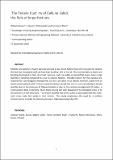| dc.contributor.author | Ronan, William | |
| dc.contributor.author | Deshpande, Vikram S. | |
| dc.contributor.author | Fleck, Norman A. | |
| dc.date.accessioned | 2016-11-02T13:37:33Z | |
| dc.date.issued | 2016-10-11 | |
| dc.identifier.citation | Ronan, William, Deshpande, Vikram S., & Fleck, Norman A. The tensile ductility of cellular Solids: The role of imperfections. International Journal of Solids and Structures. doi: http://dx.doi.org/10.1016/j.ijsolstr.2016.10.004 | en_IE |
| dc.identifier.issn | 0020-7683 | |
| dc.identifier.uri | http://hdl.handle.net/10379/6126 | |
| dc.description.abstract | Metallic and polymeric foams typically possess a low tensile failure strain of a few percent despite the fact that the parent solid can have high ductility (10% or more). This is remarkable as foams are bending-dominated in their structural response, and it is widely accepted that beams have a high ductility in bending compared to a bar in uniaxial tension. Possible reasons for this paradox are explored for a 2D hexagonal honeycomb, and for a so-called ‘lotus cellular material’, made from an elastic-plastic parent solid. Finite element simulations reveal that there is only a small drop in tensile ductility due to the presence of Plateau borders or due to the random misalignment of nodes; a much greater drop in ductility results from missing cell walls (equivalent to misshapen cells) or to the presence of stiff inclusions. The drop in ductility due to inclusions is associated with the multi-axial stress state that exists in their vicinity. This study emphasises the need for a uniform microstructure in order for foams to possess a high macroscopic ductility. | en_IE |
| dc.description.sponsorship | The authors are grateful for financial support from SABIC, and for numerous technical discussions with Dr. Martin van Es. They are also grateful for funding in the form of an ERC advanced grant 669764, MULTILAT, and to the US Office of Naval Research N62909-14-1-N232, project manager Dr. David Shifler | en_IE |
| dc.format | application/pdf | en_IE |
| dc.language.iso | en | en_IE |
| dc.publisher | Elsevier | en_IE |
| dc.relation.ispartof | International Journal Of Solids And Structures | en |
| dc.rights | Attribution-NonCommercial-NoDerivs 3.0 Ireland | |
| dc.rights.uri | https://creativecommons.org/licenses/by-nc-nd/3.0/ie/ | |
| dc.subject | Cellular foams | en_IE |
| dc.subject | Elastic plastic solids | en_IE |
| dc.subject | Finite element | en_IE |
| dc.subject | Foam structures | en_IE |
| dc.subject | Micro-mechanics | en_IE |
| dc.subject | Stress strain | en_IE |
| dc.subject | Tension | en_IE |
| dc.subject | Mechanical engineering | en_IE |
| dc.title | The tensile ductility of cellular solids: the role of imperfections | en_IE |
| dc.type | Article | en_IE |
| dc.date.updated | 2016-11-02T12:44:50Z | |
| dc.identifier.doi | 10.1016/j.ijsolstr.2016.10.004 | |
| dc.local.publishedsource | http://dx.doi.org/10.1016/j.ijsolstr.2016.10.004 | en_IE |
| dc.description.peer-reviewed | peer-reviewed | |
| dc.contributor.funder | |~| | |
| dc.description.embargo | 2018-10-11 | |
| dc.internal.rssid | 11614488 | |
| dc.local.contact | William Ronan, Mechanical Engineering, School Of Engineering, Nui Galway. Email: william.ronan@nuigalway.ie | |
| dc.local.copyrightchecked | No | |
| dc.local.version | ACCEPTED | |
| nui.item.downloads | 340 | |


